

John R. Radcliff (1843–1917) was an English flutist and inventor (1870) of the "Radcliff system" flute, a simplification of the Carte system of 1851. It was manufactured in London by Rudall, Rose and Carte, and then by Rudall Carte & Co. The instrument below is a fine example with a thinned head joint, made by Rudall Carte in 1927. (See the first page of the Rudall Carte catalog of 1922 for the price.)

The instrument had a number of proponents, including John Amadio. It was popular in Australia and New Zealand, and even among a few Irish flutists (e.g. Paddy Carty).
The instrument will sound the same as a Boehm flute, or at least a Boehm flute made by Rudall Carte, as it has the same bore, headjoint, and finger hole measurements. The only important difference is the fingering system. It is a true open-key system, and does not even have the slight veiling of the F# or Bb (with the one-and-one fingering) that the Boehm flute has
The Radcliff flute was similar to a simple system flute in the right hand. With the left hand holes closed and RH1 also down, F# sounded, not F natural. For F natural, there were THREE choices. The instrument had a short F key, something like a long F key (though finger RH2 was to be up when it was used), and the forked F, fingered 1234-6(k), was made to be in tune (actually, a bit flat and veiled), in spite of the large holes, with the aid of mechanism. An open-standing cup closes the F# hole when the long F key is depressed, or when one or both or the keys under RH2 and RH3 are closed; in particular, 1234-6 gives F natural.
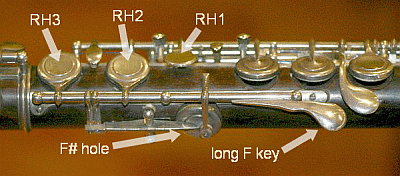
The left hand of the Radcliff was more like a Boehm flute, though with "reversed" thumb keys. So the fingerings for C and Bb were different than on a simple system flute, and C# should be played with the thumb off its key.
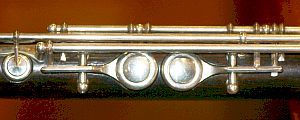
The Radcliff system flute differs from the Carte 1851 system in that it had a closed G#—more acceptable to players of the old flute—and did not have the "open D" of the Carte (where all fingers off sounds d'', and the thumb is left on its key for c''#). In my opinion, the Carte system is better (I really like the open D), but Radcliff was trying to preserve as much as possible of the fingering of the simple system flute. This was only really possible in the first two octaves, it must be said, For example, the old fingerings 12--56k and 123-56k for e''' and e'''b rely on the irrational accoustics of the simple system flute and will never work well on a flute with large holes in the correct positions; e''' and e'''b are fingered on the Radcliff just as they are on a Boehm flute
In spite of the closed G#, the high e''' is correctly vented, with only the A hole open. Anthony Baines called Radcliff's system "...an excellent design on which nothing is impossible while some high passages are simpler than on the Boehm".
The Preliminary Remarks from Radcliff's adaptation of Charles Nicholson's School for the Flute (1873) are amusing and instructive. He emphasizes the similarity of the fingering of his flute and the old eight-key flute and hopes that this will help "Flute Players trembling on the verge of a transition from the old to the new class of Flutes" make the jump. These Remarks are reproduced below. The text is given below the thumbnails, and is easier to read in this format.
(Unlike Radcliff, I do not believe for a moment that Nicholson would have given up his seven- or eight-key flute, and the effects he could produce on it and for which he was famous, for a flute without access to unencumbered open finger holes.)
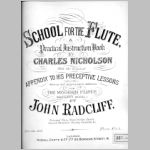
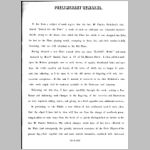
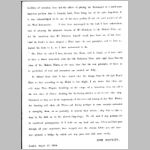
It has been a subject of much regret that the late Mr. Charles Nicholson’s celebrated "School for the Flute" a work of such an elaborate and, exhaustive character should, owing to the disuse into which the Flute for which it was designed has fallen, he lost to the Flute playing world, excepting to those few, and their number is daily lessening, who are still attached to the Old Flute.
Having adopted a new Flute termed after my name "Radcliff’s Model" and manufactured by Messrs. Rudall, Carte & Co. of 23, Berners Street, London, which is made upon the Modern principles now so well known, of equally distributed holes and open keys, the truth, equality and beauty of the notes of which can no longer be gainsaid, but adhering, as I do upon it, to the old system of fingering, with only two essential exceptions— B flat and C natural, it occurred to me that Nicholson’s valuable work might still be rendered available to the Professor and Amateur.
Following out this idea, I have gone carefully through the work, making a New Gamut and indicating such changes in the fingering of the exercises and illustrations as were required, adding others, and giving, in a brief appendix, some additional exercises.
In presenting to the Public a new edition of this celebrated work I trust, then, that the object I have had in view will free me from the charge of needlessly presuming to add to or take away from the book of so justly distinguished an Artiste as the late Mr. Charles Nicholson. The radical changes which have of late been effected in the Flute, (and consequently the greatly increased resources of the Flute Players of the present day,) their superior tone and more correct intonation, combined with increased facilities of execution have had the effect of placing the. Instrument in a much more important position than it formerly held. From being one of the more imperfect, it is now acknowledged to he one of the most perfect if not the most perfect of all the Wind Instruments I have been encouraged in the task I have undertaken— that of adapting the admirable lessons of Mr. Nicholson to the Modern Flute under the conviction that Mr. Nicholson himself would have been one of the first (had he lived) to have adopted a Flute upon the new principles, and to have adapted his book to it, as I have endeavored to do.
The Flute to which I have devoted this Book , will be found, as I have said, to have a closer connection with the Old Nicholson Flute with eight Keys, than any other of the Modern Flutes, at the same time that the new principles of these as to perfection of tone and intonation are carried out fully.
It follows from what I have stated that the change from the old eight Keyed Flute to that according to my Model is but slight, I am aware that there are still many Flute Players trembling on the verge of a transition from the old to the new class of Flutes, desiring, but hesitating whether or not to take this step. Convinced as they are of the superiority of the tone and tuning of the New Flutes, but knowing well their old Flutes, and having perhaps in some measure succeeded in managing them, so as partially to conceal their defects, they fear to take a leap in the dark as to the altered fingerings. To all such I may perhaps not be considered presumptuous if I hold out my hand and say, follow me. I have gone through all your experience, have stepped, over the stream before you, and have now planned a bridge by which you may pass over still more easily.
